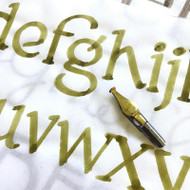Posted by Sarah @ PIA on Jan 31st 2023
We're giving you a detailed look at every Gillott nib! These high-quality dip pens were first manufactured in Birmingham, England in 1827 by Joseph Gillott. Gillott nibs still remain popular for pointed pen calligraphy today.First we'll compare two similar, often overlooked nibs. The Gillott 290 and 291 are very similar, save for a few key differences. Both nibs are small and delicate, and can easily be damaged if too much pressure is applie… Read more
Posted by Sarah @ PIA on Jan 26th 2023
There are many brands and sizes to choose from when it comes to broad-edge nibs. We're here to help you tell the difference! First up are the Brause Bandzug Nibs, which feature an oblique cut and attached reservoir. Brause calligraphy nibs have remained a popular choice amongst calligraphers for over 100 years, and feature a square shape that's perfect for rounded hands such as Italic, Roman, and Gothic. With a uniquely sharp angle, incompar… Read more
Posted by Sarah @ PIA on Jan 26th 2023
Hey, guys! Nina Tran (@anintran) from Los Angeles, CA here. The first thing I want to share: Speedball lettering nibs! Have you seen some of these before?
Randy Hasson blew my mind at the 70th IAMPETH @iampethofficial conference this year at his lecture on the history of Speedball and in his "Writing with a Bent Nib" class.The supply list alone for Randy's class was intriguing enough to get me to sign up! I just had to know what a "bent n… Read more
Posted by Sarah @ PIA on Jan 24th 2023
Ink cage nibs can make your calligraphy experience much easier! These attachments act like an ink reservoir for a pointed pen nib, allowing for lines and lines of writing without re-dipping. Using an ink cage nib requires different considerations than typical nibs, so we're here to give you some advice before you try one yourself.Ink cage nibs are created by attaching a high-tension spring to the bottom of a standard pointed pen nib. This spring… Read more




